CCW Awareness & Mindset
Developing the Concealed Carry Mindset: Enhancing Situational Awareness
At Cloudster Pillow, we understand the importance of a concealed carry mindset for responsible firearm owners. Situational awareness is a critical component of this mindset, enhancing safety and preparedness.
In this post, we’ll explore practical techniques to improve your situational awareness and integrate it with concealed carry practices. By developing these skills, you’ll be better equipped to navigate various environments while carrying discreetly and responsibly.
What Is Situational Awareness?
The Foundation of Concealed Carry Safety
Situational awareness forms the bedrock of effective concealed carry practices and concealed carry mindset. It encompasses your ability to perceive, understand, and predict events in your environment. For those who carry concealed firearms, this skill can make the difference between life and death.
The Critical Nature of Alertness
Situational awareness extends beyond mere threat detection. It involves rapid information processing and intelligent decision-making. Concealed carriers who cultivate this skill gain several advantages:
- They avoid dangerous situations before escalation occurs
- They respond more quickly to emerging threats
- They make better decisions under pressure
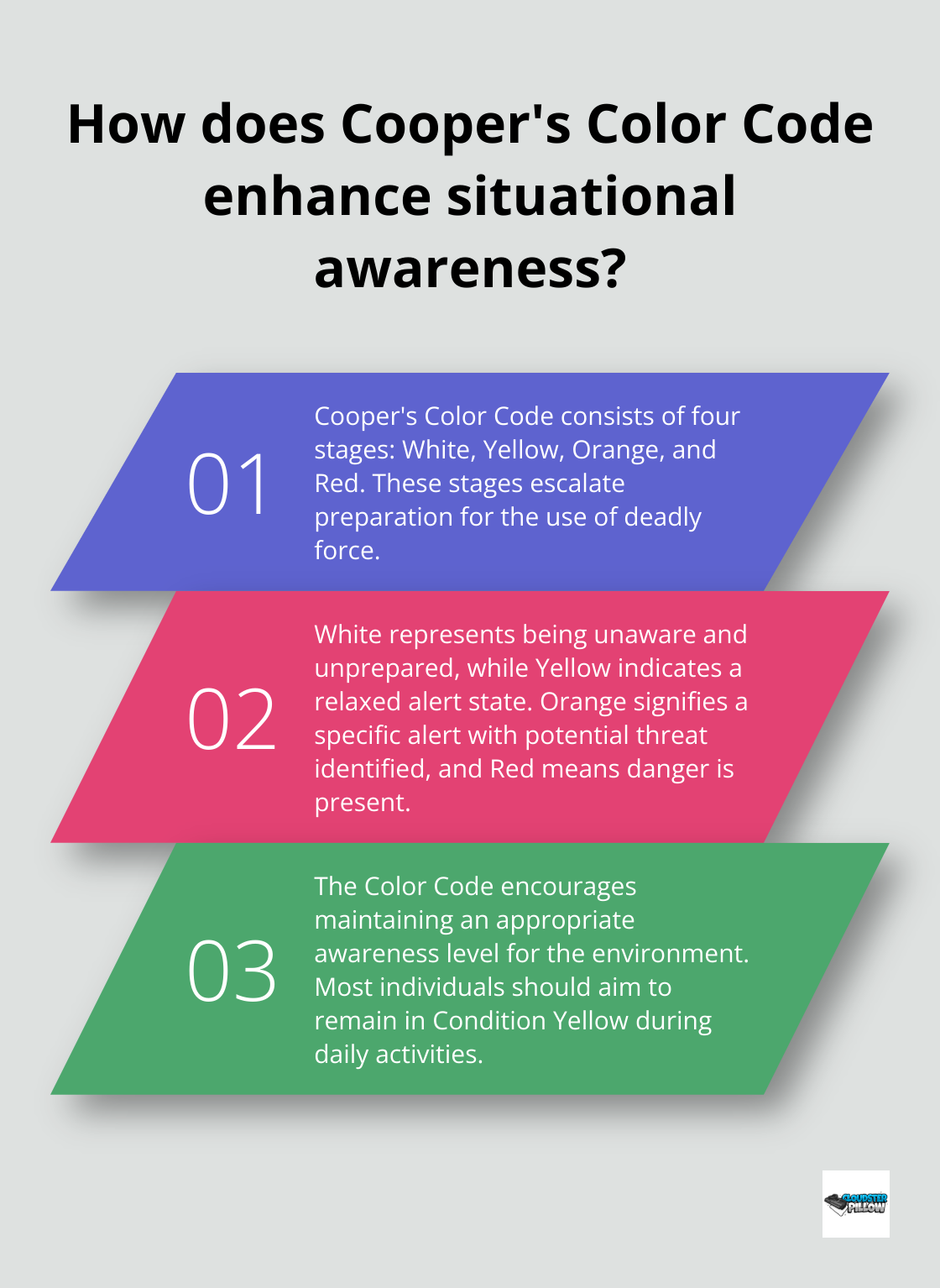
A Force Science Institute study revealed that creating realistic, stress-infused scenarios can help train and test officers’ use-of-force skills under pressure. This finding applies equally to civilian carriers.
Cooper’s Color Code: A Practical Assessment Tool
Jeff Cooper, a renowned firearms instructor, developed a simple system to help individuals assess their readiness levels. Known as the Color Code, it consists of four stages that escalate preparation for the use of deadly force:
- White: Unaware and unprepared (relaxed, not paying attention)
- Yellow: Relaxed alert (aware of surroundings, not expecting trouble)
- Orange: Specific alert (potential threat identified, ready to act)
- Red: Danger present (prepared for immediate action)
This system doesn’t promote paranoia and is key to concealed carry mindset. Instead, it encourages maintaining an awareness level appropriate to your environment. Most individuals should try to remain in Condition Yellow during their daily activities.
Practical Exercises to Enhance Awareness
Improving situational awareness requires consistent practice. Consider these exercises:
- The “What If” Game: Upon entering a new location, ask yourself: “What if a threat appeared now? Where are the exits? What could serve as cover?”
- People-Watching Practice: Notice details about those around you without staring. Observe their attire, movements, and behavior.
- Multi-Sensory Awareness: Don’t rely solely on sight. Listen for unusual sounds and note any out-of-place smells.
Situational awareness doesn’t equate to constant paranoia. It’s about preparedness and having a concealed carry mindset. With regular training, this skill becomes second nature, allowing you to carry with confidence and safety.
As we move forward, we’ll explore practical techniques to further enhance your situational awareness and integrate it seamlessly with your concealed carry practices.
How to Sharpen Your Situational Awareness and Develop a Concealed Carry Mindset
Developing keen situational awareness requires consistent practice and dedication. This skill is essential for responsible concealed carry. Here are practical techniques to enhance your situational awareness:
Establish Environmental Baselines
Create mental snapshots of your regular environments. Note typical behaviors, sounds, and patterns in places you frequent. This baseline allows you to quickly identify anomalies. In your local coffee shop, observe the usual customer flow, staff routines, and ambient noise levels. When something deviates from this norm, it’ll catch your attention more readily.
Utilize the 30-Second Assessment
Take 30 seconds to scan your surroundings upon entering a new area. Identify exits, potential cover spots, and individuals who seem out of place. This quick assessment primes your mind for rapid decision-making if a situation arises. The U.S. Department of Homeland Security recommends this technique as part of their active shooter preparedness training.
Engage Your Peripheral Vision
Expand your field of view by consciously using your peripheral vision. This technique allows you to monitor a wider area without obvious head movements. Practice by holding your arms out to your sides and wiggling your fingers. Gradually move your arms back while still detecting the finger movement in your peripheral vision.
Practice the “Three Up, Three Down” Technique
As you walk, look three people ahead, then three people behind. This method (taught in many law enforcement academies) helps you maintain awareness of your immediate surroundings without appearing overly vigilant.
Minimize Distractions
Reduce factors that compromise your awareness. Limit smartphone use in public spaces, keep music volume low if using headphones, and avoid excessive alcohol consumption when carrying. A study by the National Safety Council found that 52% of distracted walking incidents resulting in injury were due to phone use.
Conduct Regular Mental Simulations
Run through potential scenarios in your mind regularly. Ask yourself, “What would I do if X happened right now?” This mental preparation can significantly reduce reaction time in real emergencies. Mental processing time, movement time, and device manipulation time make up the “response time.” With practice, officers can improve their response times in crisis situations.
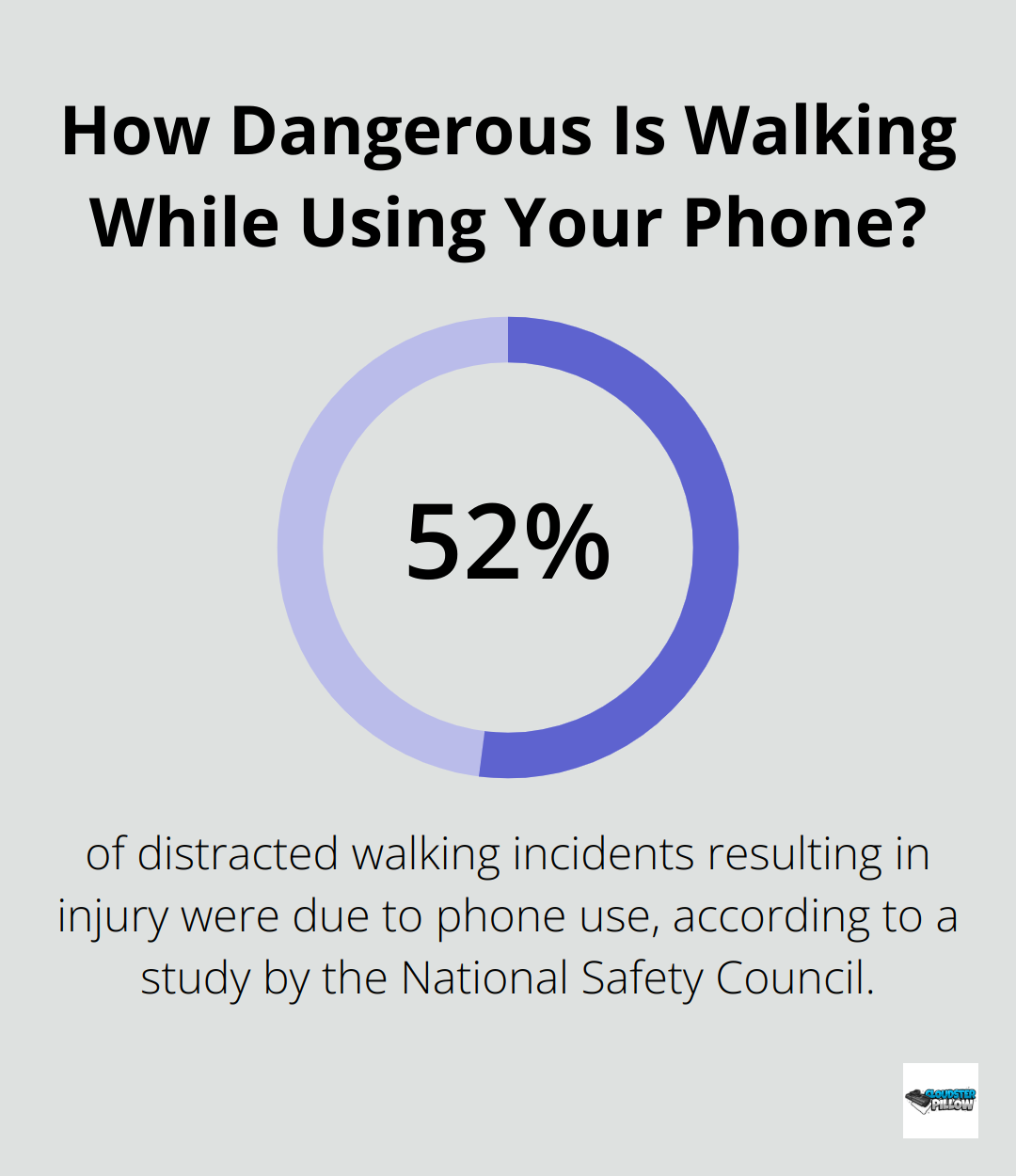
These techniques will help you develop a heightened sense of awareness that becomes second nature. The next chapter will explore how to integrate this sharpened situational awareness with your concealed carry practices and concealed carry mindset, ensuring you’re prepared for any situation that may arise.
Regular training and scenario-based exercises will help sharpen your situational awareness and conflict avoidance skills. Consider joining a local self-defense or concealed carry course to further enhance your abilities.
Mastering Concealed Carry Integration
Adapting Carry Positions to Your Environment
Your carry position should change based on your surroundings. In crowded urban areas, appendix carry often provides the quickest access and best concealment. However, when seated for extended periods (such as during long drives), a shift to a 4 o’clock position can increase comfort without sacrificing accessibility. For even greater comfort that works with any holster, many users rely on the Cloudster Pillow, a top-rated holster wedge.
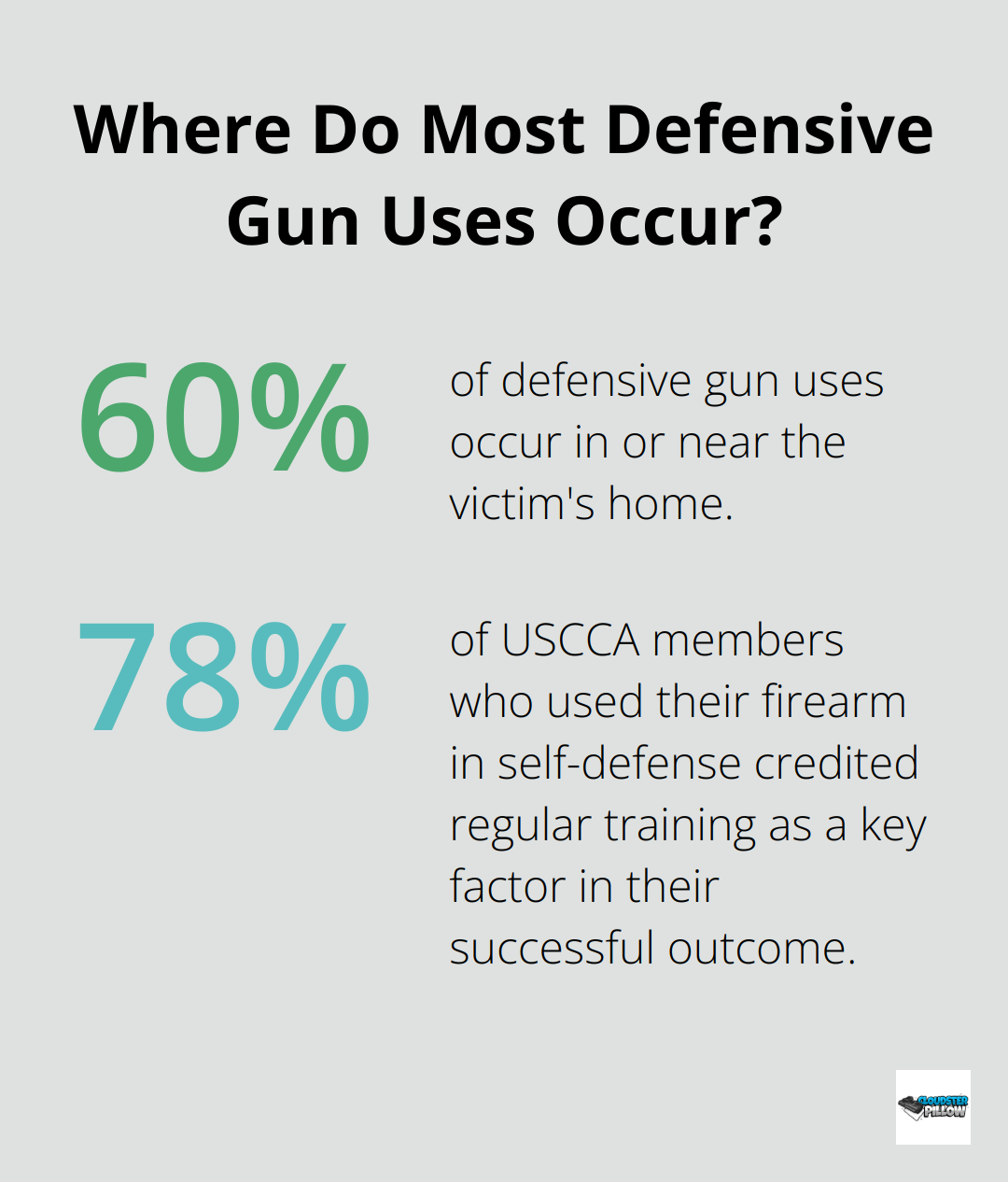
A study by the Force Science Institute found that appendix carry allowed for draw times up to 0.5 seconds faster than strong-side hip carry. This difference can prove vital in high-stress situations.
Threat-Based Carry Adjustments
As threat levels change, so should your carry method. In low-risk environments, deeper concealment might take precedence. However, as you enter areas with higher potential for danger, consider a transition to a more accessible carry position.
The National Gun Victims Action Council reports that 60% of defensive gun uses occur in or near the victim’s home. This statistic underscores the importance of a consistent home carry strategy that balances comfort with rapid accessibility.
Balancing Concealment and Access
Finding the right balance between concealment and quick access is important. Overly deep concealment can hinder your ability to respond quickly, while insufficient concealment risks unwanted attention.
One effective technique is the “tug test.” Practice drawing your firearm from concealment while wearing various outfits. If you can consistently access your weapon in under 2 seconds, you’ve struck a good balance.
Training for Real-World Scenarios
Incorporate situational awareness drills into your firearms training. Practice the identification of potential threats while you move through different environments. This could involve a scan for exits in unfamiliar buildings or a note of suspicious behavior in crowded areas.
A survey by the United States Concealed Carry Association (USCCA) found that 78% of their members who had used their firearm in self-defense credited regular training as a key factor in their successful outcome.
Gear Selection for Enhanced Awareness
Choose gear that complements your situational awareness. For example, a quality holster with adjustable retention allows you to fine-tune the balance between security and draw speed based on your environment.
Consider clothing choices that facilitate both concealment and quick access. Specifically designed concealed carry garments often feature reinforced areas to prevent printing and strategically placed openings for rapid draws.
FAQs
What is situational awareness and why is it important for concealed carry?
Situational awareness is the ability to perceive, understand, and predict events in your environment. For concealed carry holders, it’s essential for identifying potential threats early, avoiding dangerous situations, and making better decisions under pressure. By practicing situational awareness, you can react more quickly and effectively, enhancing safety for yourself and those around you.
How can I improve my situational awareness for concealed carry?
To enhance situational awareness, you can practice exercises like the “What If” game (assessing exits and cover when entering new areas), people-watching (noticing details without staring), and engaging your peripheral vision. Additionally, minimizing distractions, conducting regular mental simulations, and taking quick 30-second assessments of your surroundings will help sharpen your awareness and improve decision-making.
What is the best carry position for concealed carry?
The best carry position depends on your environment and activity. For example, appendix carry offers quick access and concealment, especially in crowded areas. However, in seated positions, such as when driving, a 4 o’clock carry can be more comfortable while still maintaining accessibility. Experimenting with different positions and adjusting based on comfort and environment is key for effective concealed carry.
How do I balance concealment and quick access to my firearm?
Balancing concealment and access is critical. Over-concealing your firearm can make it harder to draw quickly, while insufficient concealment may draw unwanted attention. The “tug test” is a practical way to test this balance—practice drawing your firearm while wearing various outfits. If you can draw within two seconds, you’ve found a good balance between concealment and quick access.
How can a holster enhance my situational awareness and comfort during concealed carry?
A high-quality holster can significantly enhance both comfort and situational awareness. Look for holsters with adjustable retention, allowing you to customize security and draw speed based on your needs. Additionally, specialized holsters like the Cloudster Pillow holster wedge improve comfort by reducing firearm printing and preventing irritation, making it easier to carry for extended periods.
Final Thoughts
A concealed carry mindset requires dedication, practice, and a commitment to personal safety. Situational awareness plays a vital role in responsible concealed carry, enhancing preparedness and decision-making capabilities. Cooper’s Color Code system provides a practical framework for assessing readiness levels, while exercises like the “What If” game help sharpen observational skills.
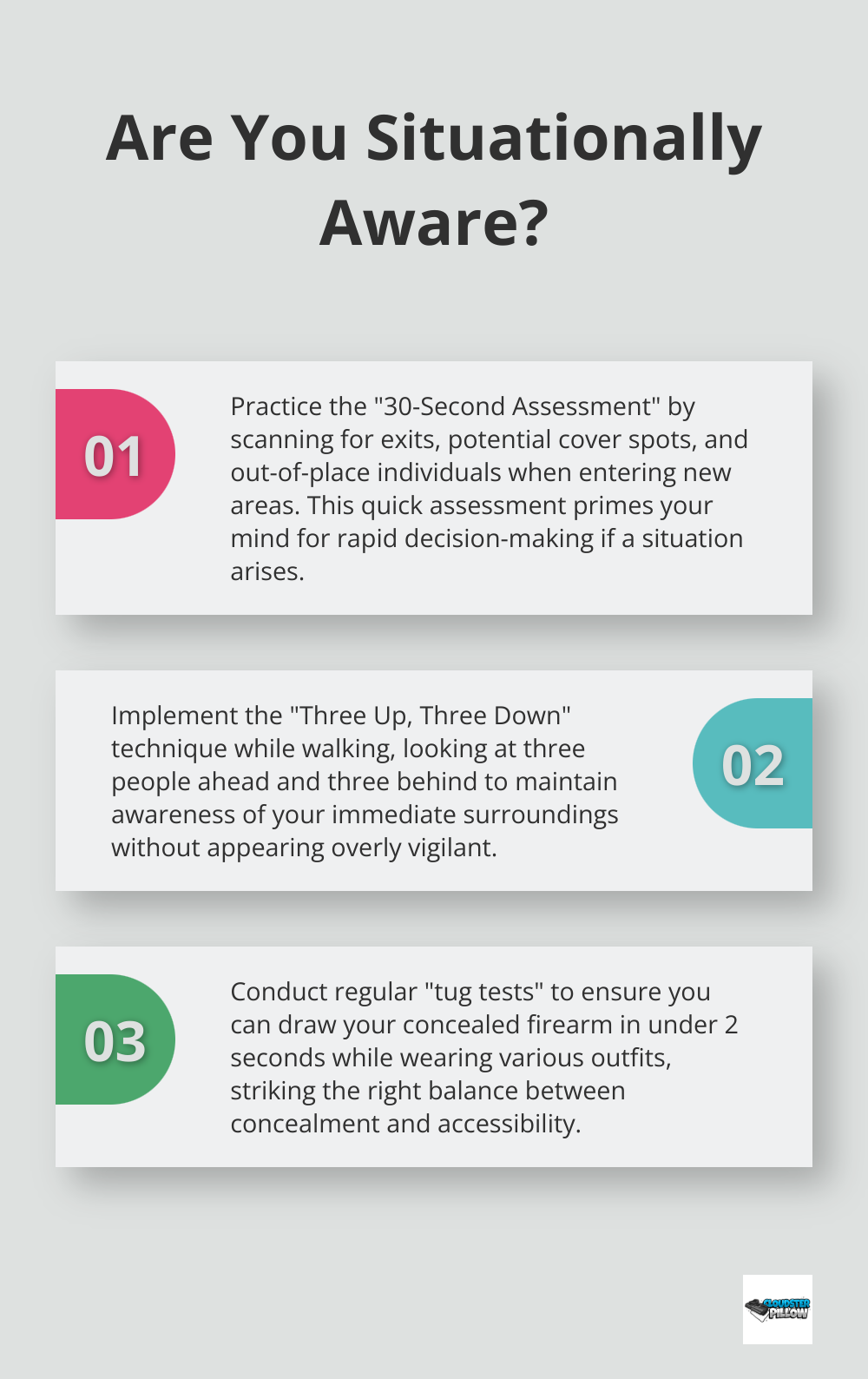
Integrating situational awareness with concealed carry practices involves adapting carry positions and adjusting methods based on threat levels. Regular training, including scenario-based exercises, improves response times in high-stress situations. The goal is to be prepared, not paranoid, while navigating various environments safely and confidently.
We at Cloudster Pillow offer an innovative solution to improve comfort and concealment for IWB and appendix carry holsters. Our adjustable shredded cooling gel memory foam pillow prevents heat buildup and irritation, while its ergonomic design supports extended wear and reduces firearm printing. This tool can enhance your concealed carry experience and contribute to your overall safety strategy.

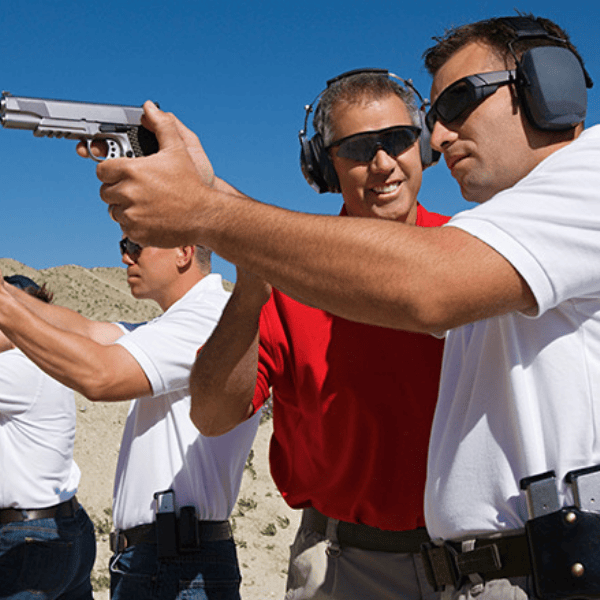
Pingback: Concealed Carry vs. Open Carry: A Comprehensive Guide - Cloudster Pillow
Pingback: Situational Awareness Training for Everyday Carry - Cloudster Pillow
Pingback: What to Expect in a Concealed Carry Class - Cloudster Pillow